Mercedes-Benz Citaro
The Mercedes-Benz Citaro is a single-decker, rigid or articulated bus manufactured by Mercedes-Benz/EvoBus. Introduced in 1997, the Citaro is available in a range of configurations, and is in widespread use throughout Europe and parts of Asia, with more than 55,000 produced by December 2019.[1]
| Mercedes-Benz Citaro | |
|---|---|
.jpg) A Citaro 2nd generation (Euro VI) in Nîmes, France. | |
| Overview | |
| Manufacturer | Mercedes-Benz |
| Production | 1997–present |
| Body and chassis | |
| Class | Integral |
| Doors | 1, 2, 3 or 4 |
| Floor type | Low floor or Low entry |
| Powertrain | |
| Engine |
|
| Capacity | 20 - 58 seats |
| Power output |
|
| Transmission | Voith Diwa.6, 4-speed automatic transmission ZF-EcoLife, 6-speed automatic transmission |
| Dimensions | |
| Length |
|
| Width | 2,550 mm (100.4 in) |
| Height | 3,130 mm (123.2 in) |
| Curb weight | 18,475–29,000 kg (40,730–63,934 lb) |
| Chronology | |
| Predecessor | O405 O405N O405N2 |
History

The first generation Citaro was launched in 1997, as a successor to the Mercedes-Benz O405.[2]
In 2005, an updated version of the Citaro to coincide with the introduction of Euro IV- (and later Euro V- and EEV-) compliant engines. Apart from minor technical alterations, mainly to accommodate the new generation of engines, the external design received a facelift to give the buses a less angular look, with internal panelling altered accordingly. Production of the old model ceased by autumn 2006.
In 2006 the Citaro received a much more substantial facelift, which can be seen from the outside by a revised front and rear design (analogous to the recently introduced low-entry buses). The hitherto characteristic feature of the first series, the "washboard trim" on the front of the vehicle, which was also available as a front advertising area and smooth surface without Mercedes star, accounted for a somewhat rounded front baffle. The lateral sweep of the front turn signals was reversed.
In May 2011, the second generation Citaro, referred to internally as the C2, was launched.[3] From 2012, the C2 could also be equipped with Euro 6 engines. The C2 versions of the Citaro LE models were the last to be presented, at Busworld Kortrijk in October 2013.[4]
Models
There are three basic versions of the Citaro available in 2019: The standard 12m Citaro, the shorter 10m Citaro K and the articulated 18m Citaro G. Hybrid versions of all three lengths and one full electric version with standard and articulated versions are also available.[5] [6]
Urban model (Current)
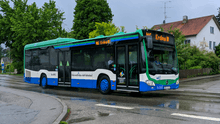

The standard urban model is available in a number of versions:
- O530: solo bus, length 12m, 2 axles, horizontal or vertical engine, 2 or 3 doors, even with front door only (in countries with left-hand traffic)
- O530 eCitaro: solo bus with full electric drive (battery), length 12m, 2 axles, 2 or 3 doors
- O530 Hybrid: solo bus with diesel-electric drive, length 12m, 2 axles, 2 or 3 doors
- O530 NGT: solo bus with natural gas drive, length 12m, 2 axles, 2 or 3 doors
- O530 NGT Hybrid: solo bus with natural gas-electric drive, length 12m, 2 axles, 2 or 3 doors
- O530 G: articulated bus, length 18m, 3 axles, horizontal or vertical engine, 3 or 4 doors, also with 2 doors only (in countries with left-hand traffic)
- O530 G Hybrid: articulated bus with diesel-electric drive, length 18m, 3 axles, 3 or 4 doors
- O530 G NGT: articulated bus with natural gas drive, length 18m, 3 axles, 3 or 4 doors
- O530 GL: articulated bus (long) (CapaCity), length 19.5m, 4 axles, 3 or 4 doors
- O530 GL II: articulated bus (long) (CapaCity L), length 21.0m, 4 axles, 4 or 5 doors (metro package)
- O530 K: midibus, length 10.5m, 2 axles, horizontal or vertical engine, 2 or 3 doors
- O530 K Hybrid: midibus with diesel-electric drive, length 10.5m, 2 axles, 2 or 3 doors
- O530 LE: low entry solo bus, length 12m, 2 axles, horizontal engine, 2 or 3 doors (the 3rd door is only available as single door)
- O530 LE Hybrid: low entry solo bus with diesel-electric drive, length 12m, 2 axles, 2 or 3 doors (the 3rd door is only available as single door)
Suburban / interurban model (Current)
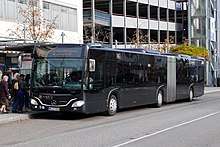
A series of suburban/interurban versions is also produced, with single front doors and all seats fitted on platforms:
- O530 GÜ: articulated bus, length 18m, 3 axles, 3 doors
- O530 LE Ü: low-entry solo bus, length 12m, 2 axles, 2 doors
- O530 LE MÜ: low-entry (medium length), length 13m, 2 axles, 2 or 3 doors (the 3rd door is only available as single door)
- O530 Ü: solo bus, length 12m, 2 axles, 2 doors
- O530 Hybrid Ü: solo bus with diesel-electric drive, length 12m, 2 axles, 2 doors
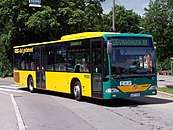 Citaro Ü 1st generation
Citaro Ü 1st generation_Qbuzz.jpg) Citaro LE Ü 1st generation facelift
Citaro LE Ü 1st generation facelift Citaro LE MÜ 2nd generation (3 doors)
Citaro LE MÜ 2nd generation (3 doors)
Discontinued models
Urban
- O530 CNG: natural gas drive, length 12m, 2 axles, 2 or 3 doors (renamed as O530 NGT)
- O530 G CNG: articulated bus with natural gas drive, length 18m, 3 axles, 3 or 4 doors (renamed as O530 G NGT)
- O530 FuelCell Hybrid: hydrogen-fuel cell hybrid drive, length 12m, 2 axles, 3 doors
- O530 G BlueTec Hybrid: articulated bus with diesel-electric hybrid drive, length 18m, 3 axles, 3 or 4 doors
- O530 L: solo bus (long), length 15m, 3 axles, 2 or 3 doors
Suburban / interurban
- O530 MÜ: solo bus (medium length), length 13m, 2 axles, 2 doors
- O530 LÜ: solo bus (long), length 15m, 3 axles, 2 or 3 doors
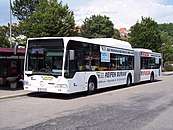 Citaro G CNG 1st generation
Citaro G CNG 1st generation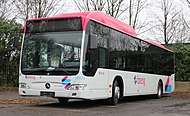 Citaro CNG 1st generation facelift
Citaro CNG 1st generation facelift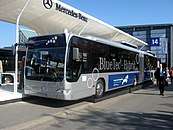 Citaro G BlueTec Hybrid
Citaro G BlueTec Hybrid
Specifications
Operators are able to choose between two different front stylings: the standard design features an angled destination display, like a roof dome, and is primarily marketed for urban buses, while a version with a one-piece windscreen covering the destination display also is available and is primarily intended for interurban use. However, all models are available with either version.
With the introduction of 2nd generation Citaro, the front destination display was slightly enlarged, which juts a bit out of the vehicle roof. As a result, Mercedes-Benz designed a small fairing at both sides of destination display. This fairing is available on all models by default. Later, after the introduction of Euro VI version, which results a complete structural change in engine compartment, also the rear destination display was enlarged and added with a fairing. However, afterwards, customers are also able to order a front display without fairing, whether urban or interurban versions.
Other customizations include the number and type of doors as well as the interior layout. Two types of seats are offered as part of the standard range, again with a basic model for urban use and an enhanced version for longer-distance routes, although both also are available on all models.
Aside from the usual diesel engines, the Citaro is also available with a powerful Euro VI natural gas engine M936G rated by 222kW. It can be optionally combined with the new hybrid system of Mercedes-Benz, which helps to save more fuel and lower emissions.[7]
Non-standard bodies
As a one-off, German operators üstra of Hanover and LVB of Leipzig took delivery of a batch of Citaros bodied to a special design by James Irvine for Expo 2000. Leipzig's vehicles were lent to Hanover for the duration of the exhibition, but subsequently returned to normal service in their home city. All other Citaros bodied by Mercedes-Benz were to standard designs, however a number of chassis were bodied by independent manufacturers, most notably Hess of Switzerland. However, the Citaro has more recently only been sold as a complete product.
In 2007 the workshops of the Szeged (Hungary) bus operator SZKT converted a regular Citaro to a trolleybus. As of April 2010, five such buses are already serving as a trolley and more examples are in preparation in the near future.[8]
In 2009, the Centre of Ambulance Services in Dubai took delivery of three Citaros, which had been modified to become the world's largest ambulances.
In 2010, the French city Rennes ordered a longer version of the Citaro, the Citaro M, which is 13 meters long with an urban arrangement. 15 vehicles were built over the chassis of the Setra S416NF.
Hydrogen fuel cell version
.jpg)
Even though the usual Citaro models are powered by diesel or natural gas, there is also a hydrogen fuel cell-powered version, designated Citaro BZ or O530BZ (BZ stands for "Brennstoffzelle" in German). During the combustion process, only water steam are produced, so the vehicle is very environmentally friendly. The hydrogen tanks are located in the roof, which results an increased vehicle height at 3.68m. These buses have 3 doors, low floor configurations, and are capable for a top speed of 70km/h. About 35 of these buses have been in service in a variety of different world cities in order to test the feasibility of hydrogen fuel cells in numerous countries or continents (including UK, Australia and China), different operating circumstances and different conditions, especially weather conditions.
Hybrid electric version
The Mercedes-Benz Citaro G BlueTec Hybrid is a series-hybrid articulated bus with a compact 450 kg, 4-cylinder, 4.8-litre, 160 kW, Euro 4 OM-924LA diesel engine providing power for a roof-mounted 19.4 kWh lithium-ion battery pack, and four 80 kW electric wheel hub motors located on the centre and rear axles. (Contrast a conventional bus diesel engine: 6-cylinder, 12-litre, 1,000 kg.) The battery pack is also charged by regenerative braking (recuperation). The manufacturer anticipates fuel consumption 20% lower than conventional diesel Citaros. [9][10][11] In 2010, selected bendy buses were delivered in hybrid version to Wuppertal, Stuttgart, Krefeld, Hamburg and Mülheim. Other buses were also delivered to Essen, Duisberg, Munich, Mainz, Hamburg and Rostock are also in the rigid versions. The Dresden and Leipzig also delivered their Citaro hybrid buses in 2011.[12]
Eventually, Daimler decided to not to upgrade BlueTec Hybrid variants to second generation of Citaro. Instead, in 2017, they launched Citaro Hybrid variants of Citaro (diesel) and NGT, which uses mild hybrid drive, much cheaper to manufacture than BlueTec Hybrid drive. It uses 14 kW, disc-shaped electric motor mounted between combustion engine and transmission for energy recuperation and can provide a torque of up to 220 Nm.[13]
Battery version / eCitaro

Since 2015, Aachen Transport runs a battery-powered Citaro articulated bus as a test in scheduled operation. The vehicle was converted in 2014 from a hybrid bus to a battery bus. They removed all diesel components and installed 1300 traction batteries with a total capacity of approximately 180 kWh. The axle loads remained unchanged. The vehicle has four wheel hub motors with 60 kW continuous power on the second and third axle and has a range of more than 50 kilometers. The conversion was carried out as part of the EU project Civitas (Cleaner and better transport in cities) and was funded by the Aachen Transport Association to 75 percent. The costs for the hardware (e.g. batteries) amounted to approximately 700,000 euros.
Mercedes-Benz tested prototypes of the Citaro with full electric drive. The bus features a modular battery pack design and use the same electric wheel hub motors as the Citaro G BlueTec Hybrid. It was launched at the IAA Commercial Vehicles show in Hanover in September 2018[14][15] as eCitaro. It uses modified bodywork of standard Citaro with front adopted from Daimler's concept Future Bus. It was first launched as 12 m solo bus. Later, an articulated 18 m version of eCitaro (also known as eCitaro G) was added to offer.
.jpg)
On 15 November 2018, the first series of eCitaro was delivered to its first customer: Hochbahn AG, a public transport company in Hamburg, with a total of 20 at last. In year 2019, there are more customers started operating eCitaros, including Rhein-Neckar-Verkehr GmbH (RNV), Berliner Verkehrsbetriebe (BVG), Zugerland Verkehrsbetriebe (ZVB), and Bus Ostschweiz (BOS). This was also followed with orders from Verkehrsbetriebe Hamburg-Holstein (VHH) with 16 buses, ESWE Verkehrsgesellschaft mbH from Wiesbaden with 56, and ÜSTRA from Hannover with 48. Mercedes-Benz also received orders from foreign countries, which contains Luxembourg, Norway, and Sweden. In addition, the eCitaro has been crowned to City Bus of the Year 2019 in Spain on 11 February 2019.[16]
Overhead wire version
Because EvoBus itself does not offer trolleybuses, the transport companies of the Hungarian city of Szeged independently built six second-hand Citaro solo vehicles into trolleybuses between 2006 and 2010. This is expected to save on spare parts inventory - this can be done together with the same diesel buses of the dispenser series - as well as lower acquisition costs compared to standard production trolleybuses. The modified type designation is O-530 Tr12, the six wagons bear the operating numbers T-860 to T-865.
In 2012, two Citaro trolleybuses also went into operation in Polish Gdynia. The cars with the numbers 3053 and 3054 originated from used acquired diesel buses from Berlin, which has been delivered in 2002.
CapaCity
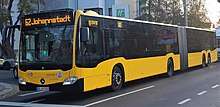
Mercedes-Benz CapaCity (also known as O530 GL) is a large-capacity articulated bus based on Citaro G, which was introduced in year 2007. The 1st generation CapaCity is 19.54m long and can carry up to 186 passengers. It features exactly the same turning circle as that of its shorter sister Citaro G (17.94m length) thanks actively steered electro hydraulic fourth axle. The safety is guaranteed by Electronic Braking System (EBS), anti-lock brakes (ABS), acceleration skid control (ASR), and the passenger comfort is improved by independent front suspensions. It is both available with 3 and 4 doors. There are also CapaCitys with BRT-Design, which can be recognized by their changed exterior. These buses are currently in service in Istanbul, Turkey and Bratislava, Slovakia.[17]
The 2nd generation CapaCity was first presented in year 2014. However, it’s the long version “CapaCity L” (21m) which became available at the beginning. The shorter version “CapaCity” with a length of 19.7m was added later. They are all based on the modular system of Mercedes-Benz Citaro. The new feature “Articulation Turntable Controller” (ATC) prevents additionally from jackknifing. CapaCity L can carry 191 passengers with standard equipment, CapaCity 182 passengers. They are offered with 4 doors by default, but with “Metro Package”, CapaCity L is also available with 5 doors, which is better constructed for BRT services. According to Daimler, CapaCity L is the diesel powered urban bus which uses the least fuel per passenger space.[18]
 CapaCity 1st generation of ASEAG Aachen
CapaCity 1st generation of ASEAG Aachen- CapaCity 1st generation with BRT-Design
Conecto
In year 2007, the 2nd generation Conecto was presented and is both available as standard 12m and articulated 18m version. They are however only available with 3 doors (solo version) and 4 doors (articulated version). Unlike its predecessor as an independent model series, it is a technically simplified version of Citaro or Citaro G, with low floor configuration and vertical engines. It is recognizable with the changed exterior design in opposition to Citaro and is mainly sold to eastern Europe and the Middle East.
In September 2016, the 3rd generation Conecto was presented in Warsaw, Poland. Several improvements were done for the new Conecto, as well as driving safety, passenger comfort, handling and Euro 6 engines, while the operation costs still stay low. Examples for high standard of safety are Electronic Stability Program (ESP) on solo versions and Articulation Turntable Controller (ATC) on articulated versions. Conecto and Conecto G NGT powered by natural gas are also available for the first time. Like the 2nd generation, the 3rd generation Conecto is solely available with 3 doors (solo version) and 4 doors (articulated version).[19]
.jpg) Mercedes-Benz O345 Conecto 2nd generation in Ústí nad Labem, Czechia
Mercedes-Benz O345 Conecto 2nd generation in Ústí nad Labem, Czechia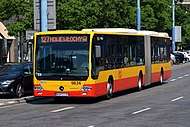 Mercedes-Benz Conecto G 2nd generation in Warsaw, Poland
Mercedes-Benz Conecto G 2nd generation in Warsaw, Poland
Production
The Citaro is currently built in factories in Mannheim, Germany and Ligny-en-Barrois, France. It was also built in Sámano in Spain.[20]
The low-cost-variant Conecto is produced by Mercedes-Benz Türk A.Ş. in Hoşdere, Başakşehir, Istanbul, Turkey. Some Citaros were also manufactured here.
Operators
Europe

Germany
In May 2018, the Berliner Verkehrsbetriebe (BVG) placed an order for a total of 950 new Citaros: 350 Citaros and 600 Citaro Gs, the first of which was delivered on 20 November 2018. Their engines are all meeting Euro VI standard, have low fuel consumption and less emissions. BVG also placed a second order with 15 eCitaro, which were delivered on the first quarter of 2019.[21][22]
Mercedes-Benz Citaro is also widely used in rest of Germany. The Hamburger Hochbahn operates the Citaro since 1997 and ordered over 1000 over the time.[23] DB Stadtverkehr GmbH, a subsidiary of Deutsche Bahn, operates a large number of Citaro or rather Citaro G. They are used in scheduled urban and interurban services in numerous federal states and cities, e.g. Aachen, Düsseldorf, München, Münster, and Stuttgart.[24]
Slovakia
In 2008 to 2013 Bratislava ordered 41 large buses of type Mercedes-Benz CapaCity to replace buses of types Ikarus 435 and Diesel buses Karosa B741. The first bus entered into service in December 2008 on route 96 with evidence number 1999. In 2010 ordered in total 25 buses and in 2012 ordered 15 buses. Bratislava also ordered 1 Citaro CNG with number 2020. Citaro CNG entered to service in November 2009 To February 2018 and today bus Citaro CNG is sold to private owner.
In 2002 Nitra ordered 1 Citaro only for route 28. Original transparents are being replaced in summer 2013 with R&G Mielec.
The Netherlands

Connexxion had ordered a total of 255 buses through out 1998 and 2014. That 255 contains the order of the 75 buses in 2019. Besides that they placed another order of 33 Capacity L buses.
The RET, from Rotterdam, has made 2 orders in 2006 and 2008 for a total of 166 Citaro buses. In 2010 they made another small order of 2 hybrid Citaro articulated buses.
Syntus, in the eastern side of the Netherlands, placed two orders for 33 buses. 11 Citaro CNG single buses under the moniker "Gelderland" and 22 articulated CNG buses under the moniker "Veluwelijn"
In 2009, Qbuzz ordered 390 while Connexxion ordered 75. As of 2018 Connexxion under the R-Net moniker took delivery of several CapaCity L models[28] In 2014 Qbuzz ordered another 138 buses for Utrecht under the moniker "U-OV."
Romania
Between 2005 and 2009 Regia Autonomă de Transport București purchased 1,000 Citaros.[29]
In September 2019, STB ordered 130 Citaro Hybrid buses with deliveries to begin in the spring of 2020.
Spain
In 2016, Empresa Municipal de Transportes de Madrid (EMT Madrid) ordered 82 natural gas versions of the Citaro, known as the Citaro NGT. The following year, it placed an order for a further 314 buses, and in 2018 it placed another order for a further 276 buses, for a total of 672 buses, all of which are due to enter service by 2020.
Italy
.jpg)
In 2001, ATAC of Rome ordered 183 Citaro MU interurban model with a blue livery and two doors.[30] This was followed by 301 Citaros urban and suburban model in the normal ATAC grey livery with 2 and 3 doors, in 2004. [31] [32] They operate on many routes, including 63, 88, 443 and many lines in Ostia.
Outside of the capital, Citaros are very popular in Italy. They can be seen in many of the big cities, including Milan, Naples, Venice, Trieste, Cagliari, Trento and Bologna.
United Kingdom
London
Right-hand drive versions of the articulated Citaro G were introduced in London on 2 June 2002, on routes 507 and 521. They were eventually used on 12 routes across London, and were operated by various Transport for London operators including East London, First London, London Central, London General and Selkent.[33][34]
In 2003 and 2004, four Citaro Gs caught fire, although there were no casualties involved. One was burnt on its delivery journey. Mercedes-Benz did address the problem, though the buses were withdrawn for some time which the saw the brief return of the just-retired AEC Routemasters. Unfortunately, the fires are said to have marred the reputation of articulated buses in the United Kingdom, and some people nicknaming them Chariots of Fire.[35]
The final Citaro G in London was withdrawn in December 2011.[36]
Twelve metre rigid Citaros were introduced in London on 27 April 2002, on route RV1. Three experimental hydrogen fuel-cell Citaros were also used on RV1 between 2004 and 2006.[37]
On 4 December 2016, Quality Line introduced the first Citaro Ks in London, on route 413.[38]
Rest of the UK
Solent Blue Line in Southampton received 10 Citaros in 2006. They were branded in the Bluestar livery and were mostly seen on the services 8 and 9 to Hythe and the waterside. Others could be seen in the colours of sister companies in the Go-Ahead group such as Oxford Bus Company, Go North East, Southern Vectis and Wilts and Dorset including the 'Pulse Line' (Salisbury) and 'More' (Bournemouth and Poole) branded services.
Between 2006 and 2009 Uno of Hertfordshire took delivery of a total of 22 12m Citaros, as well as running a small fleet of articulated 18m Citaros on their Shuttle service in Hatfield.
In 2014, Blackpool Transport ordered 10 Citaros for use on Palladium branded routes.[39] They were delivered in 2015.[40]
Citaros are also used in many airports across the UK, including Heathrow, Gatwick, Stansted, Leeds, Luton and Bristol..
In 2013 Cardiff Bus received 20 Euro 5 citaros. Then again in 2015 they received 10 Euro 6 citaros then a further 10 in 2017, bringing the total in the fleet to 40.
Asia
China
In year 2006, 3 hydrogen-fuelcell-powered Citaro buses began their test launch in Beijing, China. They ran on a 18.2 km long ring-line, which contains 11 stations and uses Summer Palace North Gate as departure/terminal station. The operating hours ranged from 9am to 3pm, the bus came approx. every 40 minutes. Each ride costs 2 CNY. During the launch, these 3 Citaro left a very positive impression to the passengers.[41][42]
Japan
In 2010, Keisei Bus ordered 15 articulated Citaro G buses, primarily for service in east Tokyo.[43]
Nishitetsu also operates several Citaro G buses on the Fukuoka BRT.
Singapore
_-_SG1126C_852_(1).jpg)
SMRT Buses trialed an Euro V demonstrator unit in 2010,[44] which proved to be successful and an additional 10 buses were purchased with a follow up order of another 40. In 2011, SBS Transit made an initial purchase of 300 buses,[45] before following up with another order of 450 (increased to 474) in 2012[46] and a further 250 (increased to 330) in 2014.[47] By 2017, a grand total of 1,155 Citaro buses have been registered, with some allocated to Tower Transit Singapore and Go-Ahead Singapore under the Bus Contracting Model.
In March 2020, a Citaro Hybrid bus with the C2 design was introduced into service with SBS Transit and was registered as SG4004B.[48]
Oceania
Australia
In Australia, between September 2004 and September 2007, Transperth trialled three hydrogen powered O530BZs.[49][50] One was preserved by the Bus Preservation Society of Western Australia with the other two scrapped at the end of the trial.[51] In 2016, Brisbane Transport trialled a Citaro demonstrator.[52][53][54]
Middle East
Saudi Arabia
The Saudi Public Transport Company (SAPTCO), in a joint venture with RATP Group, placed an order for 200 Citaros and 400 Citaro Gs on 16 May 2017. These Citaros will be specially adapted for use in the hot desert conditions of Saudi Arabia, with an uprated air conditioning system, circulating air blowers in the doors and double-glazed, darkened side windows. The first vehicles are due for delivery in 2018.[55]
Latin America
In Latin America, Citaros are not present in large quantities in public transport systems. Only Mexico has 14 Spanish-built Citaros for the BRT Internal System of UNAM.
References
- Mercedes-Benz celebrates 55,555 Citraos delivered Coach & Bus Week issue 1424 17 December 2019 page 12
- "New urban bus: Citaro first on the road in Hamburg". marsClassic.
- "Die Entwicklung steckt im Detail" [The development is in the details]. Der Rote Renner (in German). 20 May 2011. Retrieved 21 August 2015.
- "Daimler Buses at Busworld 2013". Daimler. 4 September 2013. Retrieved 21 August 2015.
- "The new Citaro hybrid" (PDF). Mercedes Benz. August 2018. Archived from the original (PDF) on 11 July 2019. Retrieved 11 July 2019.
- "The new eCitaro" (PDF). Mercedes-Benz bus. Retrieved 7 October 2019.
- "The Citaro NGT". mercedes-benz-bus.com. Retrieved 24 April 2020.
- YouTube: Mercedes-Benz Citaro trolley in Szeged. Retrieved on 31 October 2007.
- "Mercedes-Benz Citaro G Bluetec Hybrid Bus Given 2008 DEKRA Environmental Award". Green Car Congress. 2008-01-31. Retrieved 2009-02-23.
- Michael Graham Richard (2008-01-31). "Citaro Hybrid Bus Wins 2008 DEKRA Environmental Award". Treehugger. Retrieved 2009-02-23.
- "The 2008 DEKRA environmental award - The Citaro G Blue Tec Hybrid bus". Mercedes-Benz - Omnibus News. 2008. Retrieved 2009-02-23.
- "Bundesverkehrsminister übergibt Hybridbusse an Leipzig" [Federal Traffic Minister gives hybridbus to Leipzig]. Archived from the original on 2012-08-04. Retrieved 2018-05-25.. Auf Leipzig Info, 27 May 2011. Citaro hybrid buses also drive at the Mainz transport company and other German transport companies.
- "Citaro hybrid: Hybrid technology". Mercedes-Benz Buses and Coaches UK. Retrieved 2019-12-22.
- "Electric mobility: Emission-free through the city: the countdown to the Mercedes-Benz Citaro with all-electric drive has begun | marsMediaSite". marsMediaSite. Retrieved 2017-11-10.
- "What's new: Outlook on the IAA – Mercedes-Benz Buses". Mercedes-Benz Buses. Retrieved 3 April 2020.
- "eCitaro - Daimler Global Media Site". Daimler. Retrieved 7 October 2019.
- "Five Mercedes-Benz CapaCity buses in service in Tübingen". Daimler. Retrieved 14 January 2020.
- "World premiere Mercedes-Benz CapaCity L: Even longer and more spacious, even more efficient and safe: the new large-capacity Mercedes-Benz CapaCity L articulated bus measures up on all fronts". Daimler. Retrieved 16 January 2020.
- "New City Bus: World Premiere - The New Mercedes-Benz Conecto (German)". Daimler. Retrieved 25 November 2019.
- "La planta de EvoBus en Sámano cumple 10 años". www.revistaviajeros.com.
- "Citaro - a success story in Berlin: Record order for the Citaro: Mercedes Benz to deliver up to 950 city buses to Berliner Verkehrsbetriebe (BVG)". marsMediaSite.
- "Mercedes-Benz Citaro: Delivery from major order: BVG Berlin is growing". marsMediaSite.
- "Mercedes-Benz Citaro für Hamburger Hochbahn: Seit über 15 Jahren fährt der Citaro in Hamburg" (in German). Retrieved 14 April 2018.
- "Germany/DB Stadtverkehr GmbH photos (in German)". bus-bild.de. Retrieved 23 April 2020.
- Budapest orders biggest fleet to date of new Mercedes-Benz Citaro urban bus Busworld 10 December 2012
- First Mercedes-Benz Citaro buses delivered to Budapest Budapest Business Journal 2 May 2013
- "Járműpark" (in Hungarian). VT-Arriva. Retrieved 25 April 2017.
- Mercedes-Benz receives two major orders Mercedes-Benz
- Daimler Buses delivers 1,000th Mercedes-Benz Citaro to Romania Daimler 9 July 2009
- "TPLITALIA.IT". www.tplitalia.it.
- "TPLITALIA.IT". www.tplitalia.it.
- "TPLITALIA.IT". www.tplitalia.it.
- Mercedes-Benz O530 Bus Lists on the Web
- Mercedes-Benz O530G Bus Lists on the Web
- New bendy bus blaze scare London Evening Standard 2 October 2007
- Bendy bus makes final journey for Transport for London BBC News 10 December 2011
- "Route RV1". www.londonbusroutes.net.
- Deakin, Tim. "Quality Line goes for Citaro K for TfL tender". Retrieved 7 December 2018.
- "Citaros for Blackpool and McGill's". November 18, 2014.
- "Blackpool Citaro launch". Bus & Coach Buyer. May 27, 2015.
- "Fuelcell omnibus test launch Beijing (in simplified Chinese)". auto.sina.com.cn. Retrieved 4 May 2020.
- "Experienced "ultra-expensive" omnibus - Beijing hydrogen fuelcell omnibus first ride (in simplified Chinese)". chinabuses.com. Retrieved 4 May 2020.
- "Best-selling Citaro Now Also Used by Keisei Bus in Japan". Daimler Global Media Site. Retrieved 28 April 2018.
- Mercedes-Benz Citaro for South-East Asia: SMRT to test the Citaro in Singapore for the local market. Daimler 20 April 2010
- Major order from Singapore: Daimler Buses delivers 300 Mercedes-Benz Citaro city buses to Southeast Asia Daimler 21 April 2011
- Singapore transit operator places major order for 450 Mercedes-Benz city buses Daimler 18 July 2012
- SBS Transit to Add 665 More Buses SBS Transit 2 July 2014
- "Mercedes-Benz Citaro hybrid". Land Transport Guru.
- Sustainable Transport Energy Project Global Hydrogen Bus Platform
- EcoBus Department of Transport
- Hydrogen Fuel Cell Buses Rattler issue 431 January 2010 pages 12-15
- Chassis: 2016 Supplier Outlook Australasian Bus & Coach 8 February 2016
- Video Review: Mercedes-Benz Citaro Australasian Bus & Coach 10 March 2016
- News Roundup Queensland Australian Bus Panorama issue 32/5 March 2017 page 18
- "Contract signed for major order: 600 Mercedes-Benz Citaro buses ordered for Saudi city transport operations in Riyadh". marsMediaSite.
- 100 Mercedes-Benz Citaro buses Abu Dhabi Archived 2016-04-15 at the Wayback Machine Mercdes-Benz
External links
| Wikimedia Commons has media related to Mercedes-Benz Citaro. |
- EvoBus
- Mercedes-Benz bus homepage
- Mercedes-Benz/EvoBus Citaro page
- Mercedes-Benz/EvoBus Citaro G page
- Paumgarten, Nick (2008-05-26). "Ich Bin Ein M4". The New Yorker. Retrieved 2008-05-24.